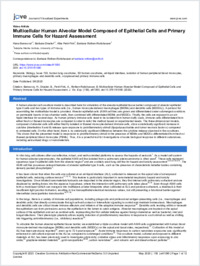Multicellular human alveolar model composed of epithelial cells and primary immune cells for hazard assessment
- Barosova, Hana Adolphe Merkle Institute, University of Fribourg, Switzerland
- Drasler, Barbara Adolphe Merkle Institute, University of Fribourg, Switzerland
- Petri-Fink, Alke Adolphe Merkle Institute, University of Fribourg, Switzerland - Chemistry Department, University of Fribourg, Switzerland
- Rothen-Rutishauser, Barbara Adolphe Merkle Institute, University of Fribourg, Switzerland
-
06.05.2020
Published in:
- JoVE (Journal of Visualized Experiments). - 2020, no. 159, p. e61090
English
A human alveolar cell coculture model is described here for simulation of the alveolar epithelial tissue barrier composed of alveolar epithelial type II cells and two types of immune cells (i.e., human monocyte-derived macrophages [MDMs] and dendritic cells [MDDCs]). A protocol for assembling the multicellular model is provided. Alveolar epithelial cells (A549 cell line) are grown and differentiated under submerged conditions on permeable inserts in two-chamber wells, then combined with differentiated MDMs and MDDCs. Finally, the cells are exposed to an air-liquid interface for several days. As human primary immune cells need to be isolated from human buffy coats, immune cells differentiated from either fresh or thawed monocytes are compared in order to tailor the method based on experimental needs. The three- dimensional models, composed of alveolar cells with either freshly isolated or thawed monocyte-derived immune cells, show a statistically significant increase in cytokine (interleukins 6 and 8) release upon exposure to proinflammatory stimuli (lipopolysaccharide and tumor necrosis factor α) compared to untreated cells. On the other hand, there is no statistically significant difference between the cytokine release observed in the cocultures. This shows that the presented model is responsive to proinflammatory stimuli in the presence of MDMs and MDDCs differentiated from fresh or thawed peripheral blood monocytes (PBMs). Thus, it is a powerful tool for investigations of acute biological response to different substances, including aerosolized drugs or nanomaterials.
- Faculty
- Faculté des sciences et de médecine
- Department
- Département de Chimie, AMI - Bio-Nanomatériaux
- Language
-
- English
- Classification
- Biological sciences
- License
- License undefined
- Identifiers
-
- RERO DOC 328820
- DOI 10.3791/61090
- Persistent URL
- https://folia.unifr.ch/unifr/documents/308727
Statistics
Document views: 87
File downloads:
- fin_mha.pdf: 417
